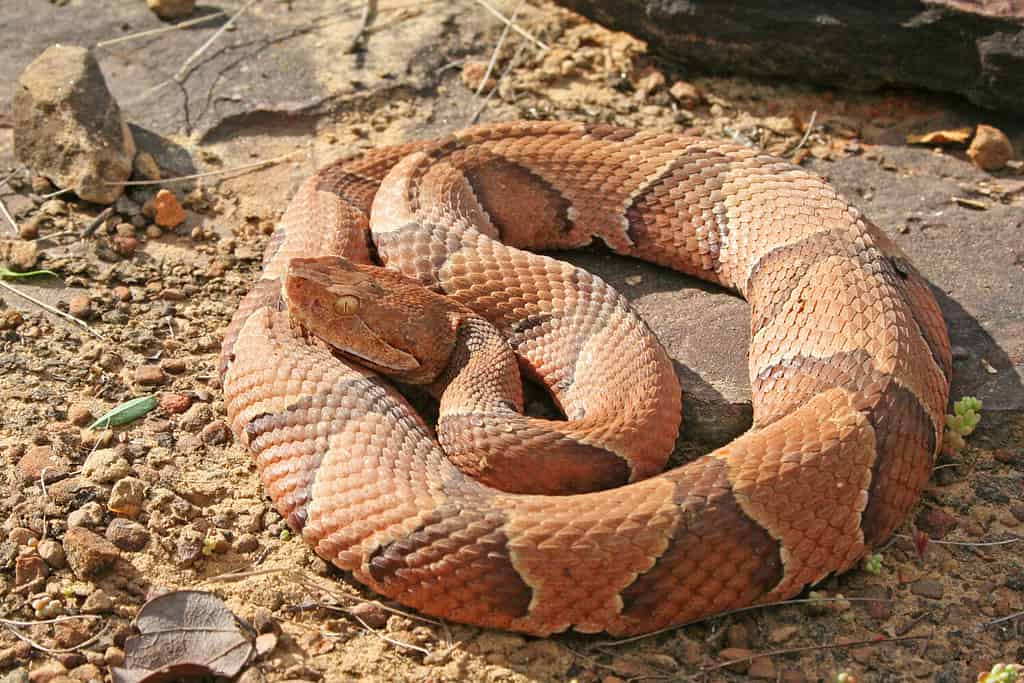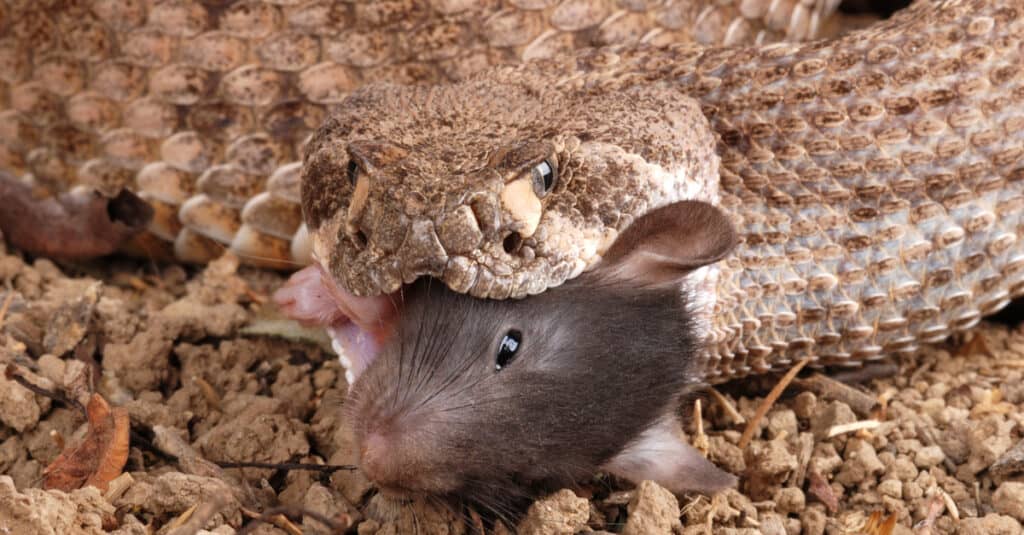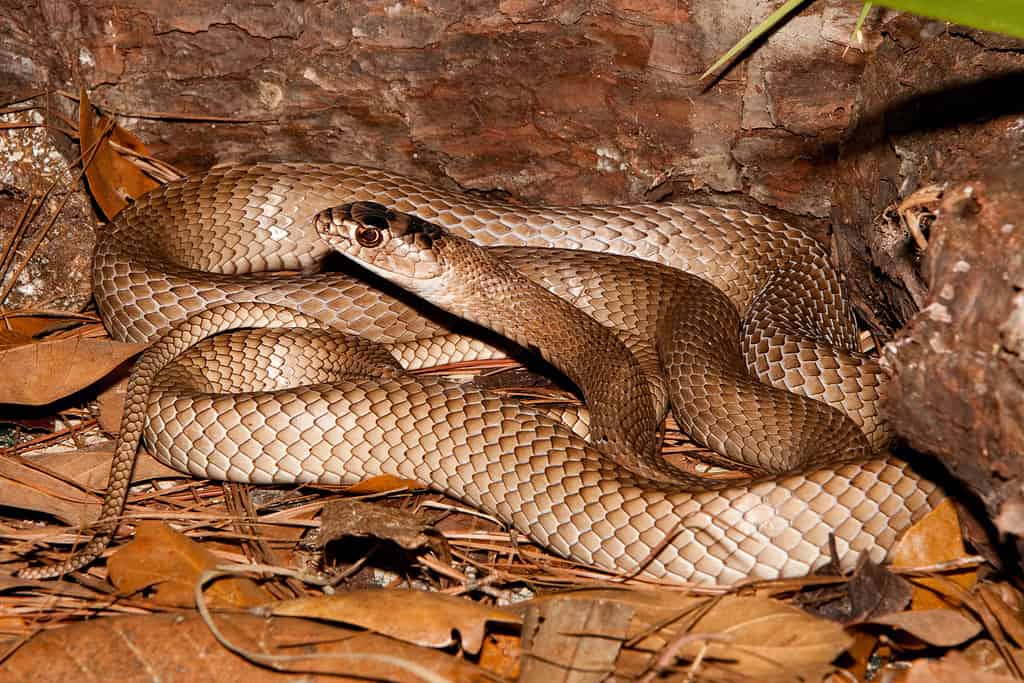Snake encounters at Lake Travis are rare but possible. We are talking about Texas, after all, and snake encounters go with the territory. Lake Travis is a reservoir in central Texas, fed by the Colorado River as it winds its way down and throughout the Lone Star State.
There are roughly eight species of snakes you might encounter on Lake Travis and some of them are venomous while some are not. The good news is, snake encounters are pretty rare, regardless of where you are. Snakes prefer to avoid human beings if possible.
However, occasionally, the two cross paths, and snake bites are often the result of defensive responses. If you’re vacationing in Texas or just heading out for some fun on Lake Travis, here are 8 snakes you might encounter out there and how to react if you do.
1. Cottonmouths

Cottonmouths are venomous snakes.
©Marcum Havens/Shutterstock.com
Otherwise known as a water moccasin, a cottonmouth is instantly recognizable when it opens its mouth. The interior looks as if it’s lined with pure, white cotton, a feature that stands out among the pit vipers. Of course, it has to open its mouth to give itself away to most of the undiscerning observers.
There are other ways to identify it, however. Cottonmouths are typically heavy-bodied snakes, at least when full-grown. They often feature a dense series of patterns dominated by crossbands and speckles (black or dark brown) throughout. As they get older, they get darker and darker, until the bands are nearly invisible among the black.
Cottonmouths spend a lot of time near water and prefer marshes and areas along the shoreline where the sun strikes the most. An adult will reach 3 to 3 and 1/2 feet in length.
2. Copperheads

Coiled copperhead lying in wait.
©Creeping Things/Shutterstock.com
One of the more common snake encounters at Lake Travis is with the copperhead. If you catch one out in the open, they are easy to identify with brilliant tan and brown crossbands featuring an hourglass-like shape.
Unfortunately, most copperhead bites are the result of stepping on or near them while they’re nestled among the leaves. Copperheads blend in very well with leaf-covered ground, especially in the fall or among dead leaves.
Since copperheads are capable of tolerating a wide range of environmental conditions, you’ll find them across the entire eastern half of the United States. Lake Travis is no exception. They aren’t very aggressive snakes and will only bite humans if their territory is suddenly disturbed.
3. Coral Snakes

Coral snakes are brightly colored and have distinctive bands.
©iStock.com/JasonOndreicka
A coral snake is not a pit viper. Instead, it belongs to a family closely related to cobras. It’s not the most common of snake encounters at Lake Travis and, when you spot one, it’s easy to identify it.
Coral snakes feature a series of black, red, and yellow bands with the red and black bands being the thickest along with a narrow yellow band that always touches the red band.
It’s an important distinction to keep in mind as there are many varieties of snakes out there with similar colorations. However, the coral snake is the only one that has a yellow band touching the red band.
4. Western Diamondback

Western diamondback happily consumes a mouse.
©Audrey Snider-Bell/Shutterstock.com
The western diamondback is a well-known pit viper throughout the state of Texas. They aren’t the most prevalent snakes in the area but there’s always the possibility you might run into one. On the bright side, run-ins with rattlesnakes (unless it is a sudden and surprising run-in) are precipitated by a very loud, warning rattle from the snake’s well-recognized tail.
You’ll know well before you step on a western diamondback, or any other rattlesnake on this list, what’s lying in wait. In case you run into an uncharacteristically quiet western diamondback, they feature diamond-shaped markings along their back and they tend to have an overall faded blue jeans look from light browns to very faded blues and grays.
5. Mojave Rattlesnake

An adult Mojave rattlesnake in a defensive stance.
©Shoemcfly/iStock via Getty Images
As the picture above indicates, rattlesnakes don’t mess around and you will often be aware of its presence long before you step into striking distance. The Mojave rattlesnake is not as abundant and pervasive as the Western rattler but it’s abundant enough to make the “snake encounters at Lake Travis” list.
As you can see, it has a distinct pattern of dark brown and black patches along a much lighter, tan background. It has a streamlined and narrow rattler, almost to a point and Mojave rattlers won’t hesitate to use it as a loud and effective warning mechanism.
While it is a little similar to the western diamondback (and might easily be confused for one), Mojaves are smaller rattlesnakes, with bodies that are smaller as well as a shorter length.
6. Texas Rat Snake

The Texas rat snake is a relatively long snake, measuring about 4 to 6 feet in size.
©South O Boy/Shutterstock.com
The Texas rat snake is far less interested in you than it is in rats, frogs, birds, and insects of the larger variety. While that sounds great, it doesn’t mean you will never step on one or encounter one in the wild. They get pretty long too, often reaching lengths between 4′ and 6′, an intimidating size for those who have little in the way of snake experience.
Texas rat snakes have a variety of colors and the patterning is often indecipherable against the backdrop color. Expect browns, grays, reds, yellows, and greens for starters. A rat snake is generally pretty narrow unless it just ate a big meal.
They are also harmless around people. Most will probably run but some rat snakes utilize an interesting form of mimicry, attempting to wiggle their decidedly non-rattley tail to trick you into thinking it’s a rattlesnake. Nice. Not very effective on humans though.
7. Bullsnake

Bullsnake coiled and resting its chin on itself.
©GoodFocused/Shutterstock.com
Another non-venomous reptile, bullsnakes are often involved in snake encounters at Lake Travis. Like rat snakes, they tend to seek out small rodents, such as rats and mice. However, they will happily settle for a frog or a salamander, if not a large insect.
As constrictors, bullsnakes strike and envelop their prey, literally squeezing the life out of them until they are fit to consume at the bullsnake’s pleasure. Bullsnakes feature heavy bodies and a variety of colorations. At first glance, they resemble something far more dangerous than what they really are.
8. Coachwhip

Eastern coachwhip relaxing on a bed of leaves against a fallen tree.
©Jay Ondreicka/Shutterstock.com
Of all the potential snake encounters at Lake Travis, this might just be the most impressive (assuming you like snakes). That’s because a coachwhip is capable of reaching 8′ in length. They aren’t very thick snakes, however, just really long and narrow.
It has a really long and extremely narrow tail, which resembles that of a whip (hence the name). Coachwhips are typically pretty dark, with deep bronzes juxtaposed against midnight blacks. They can also be bright, however, with very tan overtones mixed with browns and greys.
Fortunately, they are largely non-aggressive and would prefer to slither away from you rather than stick around to see what you will do. Stepping on top of logs and rocks will reduce the chance of a snake bite as well since snakes like to hang out next to them, rather than on top.
What to Do About Snake Encounters at Lake Travis
First and foremost, never attempt to pick up a snake, even if you have a snake for a pet back home, it’s never a good idea to attempt contact in the wild. For the most part, snakes will attempt to quickly make themselves scarce upon detecting your approach.
If you plan on hanging out in areas around Lake Travis where there is a lot of recreation going on, you will probably never see a snake. They’ll find somewhere else to be. If you like to go off the beaten path, however, there are a few safety precautions you should heed.
- Always have someone accompany you, just in case
- Pay attention to your immediate surroundings and never step or reach blindly
- Avoid heavy underbrush and bushes
- Always step on rocks or logs, not around them
- Don’t wander around the woods in the dark
- Wear tough hiking boots or other boots that cover your ankles or higher
Will this eliminate all snake bites? Most likely. Snakes will endeavor to get out of your way as long as they have plenty of warning.
Other Animals Around Lake Travis

Beautiful panoramic view of Lake Travis at the height of summer.
©Roschetzky Photography/Shutterstock.com
While most of the animals living throughout the area close to Lake Travis are docile and harmless to humans, there are some other animals that you should worry about, primarily scorpions. They’re a lot bigger than wasps and their stingers hurt a lot more.
The striped bark scorpion is the most common scorpion throughout the Lone Star State. Encountering one at Lake Travis most likely means placing your hand on the ground near a batch of dead leaves or using your hands to flip over a log or tree branch.
Lake Travis is home to a number of animals that most people will appreciate, however. Blackbuck antelope, herons, ospreys, deer, bats, and a variety of fish call the lake and the surrounding area, home. Lake Travis is the deepest lake in the Austin, Texas area and is rich with marine life.
Zebra mussels are abundant in the lake, along with bluegill, sunfish, blue catfish, channel cats, flathead cats, and black bass.
Final Thoughts on Snake Encounters at Lake Travis
Remember, snakes are like most animals. They don’t want to be in the same place as you and will happily move along with your approach. The ones that bite are the ones startled into defensive posturing (at least in America).
Practice common sense safety precautions, like the ones we listed above. If you are bitten by a snake, even if it’s a non-venomous constrictor, contact the local emergency medical services. Even non-venomous bites may contain bacteria that could become very detrimental if left untreated.
The photo featured at the top of this post is © Audrey Snider-Bell/Shutterstock.com
Discover the "Monster" Snake 5X Bigger than an Anaconda
Every day A-Z Animals sends out some of the most incredible facts in the world from our free newsletter. Want to discover the 10 most beautiful snakes in the world, a "snake island" where you're never more than 3 feet from danger, or a "monster" snake 5X larger than an anaconda? Then sign up right now and you'll start receiving our daily newsletter absolutely free.
Thank you for reading! Have some feedback for us? Contact the AZ Animals editorial team.







